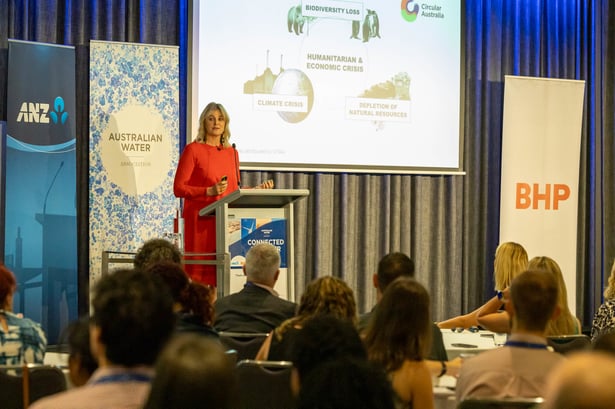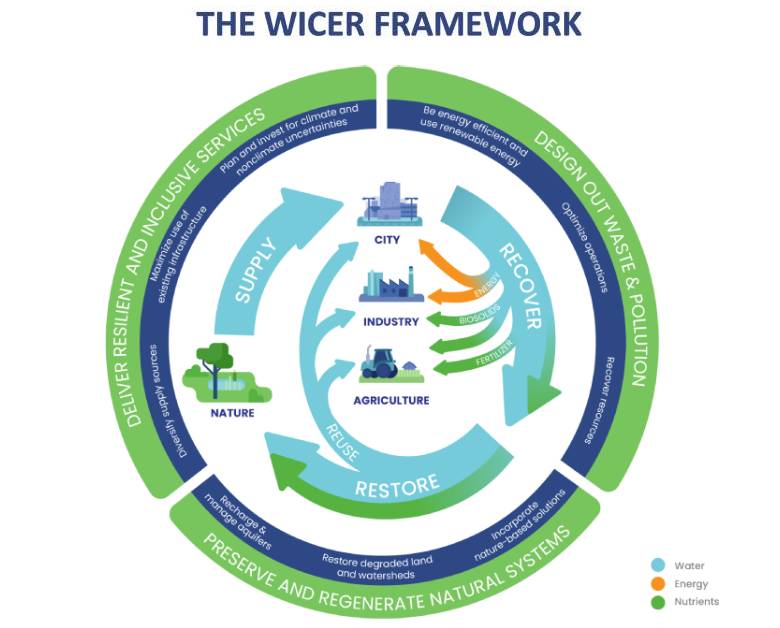Water: A Foundational Resource for a Circular Economy
.jpg)
Day two of Connected by Water featured a call to action on the importance of water as a resource in building a successful circular economy. Lisa McLean, Chief Executive of Circular Australia proposed that delegates and the wider Australian public must do more to help Australia become a circular economy by 2030.
The cold hard truth is material consumption in Australia has more than doubled in the past 40 years.
“If everyone consumed like Australians, we’d need four and a half planets to live on,” McLean stated in her keynote address.
But if the circular economy is so necessary to achieve net zero and presents a $1.9 trillion economic opportunity to industry, why is Australia denying itself an incredible opportunity?
“We haven’t owned the supply chain,” McLean said. And without the opportunity to “control” aspects of it, many of the benefits are also lost overseas.
The nation’s geography has also taken a large toll.
“[Australia is] a big country that’s spread out like Vegemite … So we’ve had to put a lot of resources into transport.”
Enter... the circular economy
What is a circular economy?
A circular economy is a model of resource production and consumption that involves sharing, leasing, reusing, repairing, refurbishing, and recycling existing materials and products for as long as possible.
Lisa McLean, Chief Executive of Circular Australia relayed that the global economy is now only 7.2% circular and the global situation is getting worse year on year - driven by rising material extraction. This extraction has shrunk global circularity from 9.1% in 2018 to 8.6% in 2020 and last year to a low of 7.2%.
Currently, Australia has a circularity rate or 5.4%, a sobering statistic demonstrating how far our lucky country is from achieving a full circular economy.
The circular economy is based on three principles
- Design out waste and pollution at every stage of production, use and end-of-life.
- Keep products and materials in use at their highest possible value.
- Regenerate natural systems e.g. through water, food, organics recycling, the removal of toxic waste, tree planting.
Even in a fully renewable energy system, ongoing high consumption, a lack of circular design, engineering infrastructure including recycling and manufacturing will still drive high emissions.
"The reasons why governments around the world are focusing on circular economy is because it can solve issues that are of a humanitarian and economic crises including climate, biodiversity loss and depletion of natural resources" - Lisa McLean
The plan for a circular economy by 2030
Minister's agreed to work with the private sector to design out waste and pollution, keep materials in use and foster markets to achieve a circular economy by 2030.

Ellen MacArthur Foundation, Completing the picture: How the circular economy tackles climate change (2019).
The Circular Economy Ministerial Advisory Group have a seven meeting stage to develop and execute a circular economy over two years. The structure includes
- February 2023 - Meeting 1 - Develop workplan
- May 2023 - Meeting 2 - Circular design and consumption of products
- August 2023 - Meeting 3 - Built environment and carbon emissions
- October 2023/March 2024 - Meeting 4 - Innovation, economics and indicators
- May 2024 - Meeting 5 - Food, resources and trade
- July 2024 - Meeting 6 - Place-based water, First Nations
- TBC - Meeting 7 - Roadmap, report and roadshow
Currently, we are in the fourth stage, Innovation, economics and indicators and we are preparing for Place-based water and First Nations for this upcoming July meeting. More consultation and research is vital to understand how we propel Australia to become a viable economy. Unfortunately, material consumptions in Australia has more than doubled over the past 40 years and Australia has the 4th lowest material productivity in the Organisation for Economic Co-operation and Development (OECD).
Water is a foundational resource in the circular economy
Water is vital to human progress, but we have exceeded our planetary boundaries.
By 2030, global demand for freshwater will exceed viable resources by 40%, if we continue with business as usual.
"The circular economy is the only viable economic framework to grow jobs and industry in a resource and carbon constrained future." - Lisa McLean
Understanding the governance across the entire water cycle is how Australia will be able to design out:
- waste and pollution;
- scale water reuse;
- attract value; and
- regenerate natural systems.
To extract the full water value we need to go from 'Take, Make, Waste' to Circular.
Through the Water in Circular Economy and Resilience (WICER) framework, we can harness the full value of water to;
- Deliver resilient and inclusive services
- Design out waste and pollution; and
- Preserve and regenerate natural systems
Applying the WICER framework provides not only environmental benefits, but also social, economic, and financial ones. Investments in circular and resilient systems yield economic and financial payoffs and can help utilities attract private sector financing. To avoid being locked into linear and inefficient systems, low-and middle-income countries can leapfrog and apply the WICER framework to design and implement circular and resilient water systems from the outset.
Building a circular water smart society
All available water sources must be included to create a true circular water-smart society and, in addition, we need to consider these crucial 6 aspects:
- Discourage and ban use of drinking water for non-potable purposes e.g. construction/renovation;
- Encourage and mandate alternate circular water sources through regulation and building codes;
- Replace with smart, efficient and safe circular water sources for non-potable (e.g. gardens, green roofs, walls);
- Accelerate the implementation of globally accepted standards for safe circular water use
- Safeguard public health and make water reuse available at a lower cost than drinking water by applying fit-for-purpose water quality criteria
- Encourage public-private collaboration among water sector stakeholders to play a leading role in the transformation to a circular economy
To lead Australia's circular economy transition, the water sector must be included in high-level circular economy strategic discussions.
We need to identify the role of water in the circular economy. Without water, there is no opportunity.
A $1.9 trillion economic opportunity
The Australian estimated economic boost over the next 20 years from circular solutions is estimated at $1.9 trillion.
“We’re not going to get to net zero unless we embrace the circular economy,” McLean said, adding that doing so means more than focusing on economic benefit.
“We need an economic model that can [also] tackle biodiversity loss, the climate [crisis] and depletion of natural resources — and this is a major issue.”
Lisa finished her keynote presentation with a call to action to focus on three specific areas for a successful circular economy
- Made in Australia - fund more opportunities for growth within our own country
- Re-Made in Australia - recycle, reuse items and resources
- Buy Australian - don't buy overseas
"The circular economy can generate hundreds of thousands of new full time jobs. Australia is primed and ready, we just need to be better at recognising the role of water. Do your part to help get us to an Australian 2030". - Lisa McLean.
Find out more on the inaugural Connected by Water conference including photo galleries and recaps.




